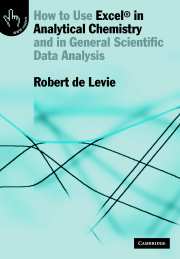6 - Spectrometry, chromatography, and voltammetry
Published online by Cambridge University Press: 05 June 2012
Summary
This short chapter contains a somewhat disparate collection of topics, commonly treated in either quantitative or instrumental chemical analysis. They illustrate a variety of methods, but their order is of no particular importance. The reader should therefore feel free to pick and choose from them, in any order.
In the first examples, spectrometry is used as an excuse to revisit some of the problems and methods encountered in earlier chapters, such as the determination of the pKa of an indicator dye, and multicomponent analysis. We also illustrate the still little-known absorbance–absorbance diagrams.
We use chromatography as our pretense to simulate the action of a differential equation. In a second chromatographic exercise, we show how the van Deemter plot can be linearized.
Our example in polarography illustrates how a spreadsheet can be used to simulate a rather complex curve, in this case reflecting the interplay between the Nernst equation, Fick's law of diffusion, and drop growth. The first two factors also play a role in cyclic voltammetry, where we introduce semi-integration as an example of deconvolution.
Spectrometric pKa determination
Spectrometry can be used to determine the pKa of a weak acid. Here we will show this with a data set that is already more than 60 years old, at the same time illustrating that the quality of the data usually depends much more on the experimental care taken in obtaining them than on the availability of the latest instrumentation.
Information
- Type
- Chapter
- Information
- How to Use Excel® in Analytical ChemistryAnd in General Scientific Data Analysis, pp. 223 - 264Publisher: Cambridge University PressPrint publication year: 2001
